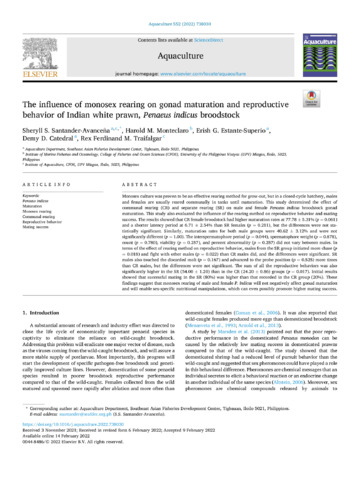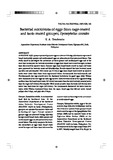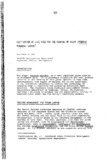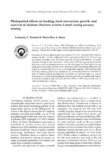The influence of monosex rearing on gonad maturation and reproductive behavior of Indian white prawn, Penaeus indicus broodstock

Tingnan/
Petsa
2022-02May-akda
Page views
396Metadata
Ipakita ang buong tala ng itemCited times in Scopus
Share
Abstract
Monosex culture was proven to be an effective rearing method for grow-out, but in a closed-cycle hatchery, males and females are usually reared communally in tanks until maturation. This study determined the effect of communal rearing (CR) and separate rearing (SR) on male and female Penaeus indicus broodstock gonad maturation. This study also evaluated the influence of the rearing method on reproductive behavior and mating success. The results showed that CR female broodstock had higher maturation rates at 77.78 ± 5.31% (p = 0.061) and a shorter latency period at 6.71 ± 2.54% than SR females (p = 0.211), but the differences were not statistically significant. Similarly, maturation rates for both male groups were 40.62 ± 3.12% and were not significantly different (p = 1.00). The interspermatophore period (p = 0.044), spermatophore weight (p = 0.878), count (p = 0.780), viability (p = 0.257), and percent abnormality (p = 0.257) did not vary between males. In terms of the effect of rearing method on reproductive behavior, males from the SR group initiated more chase (p = 0.018) and fight with other males (p = 0.022) than CR males did, and the differences were significant. SR males also touched the discarded molt (p = 0.167) and advanced to the probe position (p = 0.525) more times than CR males, but the differences were not significant. The sum of all the reproductive behaviors was also significantly higher in the SR (54.00 ± 1.20) than in the CR (24.20 ± 0.86) groups (p = 0.017). Initial results showed that successful mating in the SR (80%) was higher than that recorded in the CR group (20%). These findings suggest that monosex rearing of male and female P. indicus will not negatively affect gonad maturation and will enable sex-specific nutritional manipulations, which can even possibly promote higher mating success.
Suggested Citation
Santander-Avancena, S., Monteclaro, H., Estante-Superio, E., Catedral, D. D., & Traifalgar, R. F. (2022). The influence of monosex rearing on gonad maturation and reproductive behavior of Indian white prawn, Penaeus indicus broodstock. Aquaculture , 522, 738030. https://doi.org/10.1016/j.aquaculture.2022.738030
Paksa
Taxonomic term
Mga koleksyon
- AQD Journal Articles [1249]
Related items
Showing items related by title, author, creator and subject.
-
Bacterial microbiota of eggs from cage-reared and tank-reared grouper, Epinephelus coioides
Tendencia, Eleonor (European Association of Fish Pathologists, 2004)At SEAFDEC AQD, opaque spawned grouper eggs are observed during collection in cage-reared brood stock; while opaque and multi-colored eggs are often observed in tank-reared fishes. This study aimed to investigate the ... -
Cultivation of live feed for the rearing of sugpo (Penaeus monodon) larvae
Yap, Wilfredo G. (European Mariculture Society, 1979)The sugpo, Penaeus monodon, is a very important prawn species in Southeast Asia. It is extremely euryhaline and fast growing. Interest in the farming of this prawn species is very high. Unfortunately, the supply of natural ... -
Photoperiod effects on feeding, food conversion, growth, and survival of abalone (Haliotis asinina Linne) during nursery rearing
Fermin, Armando C.; Buen Shela Mae A. (Phuket Marine Biological Center, 2001)Juveniles of Haliotis asinina, 10 mm shell length were subjected to four photoperiodic regimes namely, 6L:18D, OL:24D, diffused 12:12D, and ambient light (12L:12D) serving as control. Juveniles were fed fresh seaweed, ...



